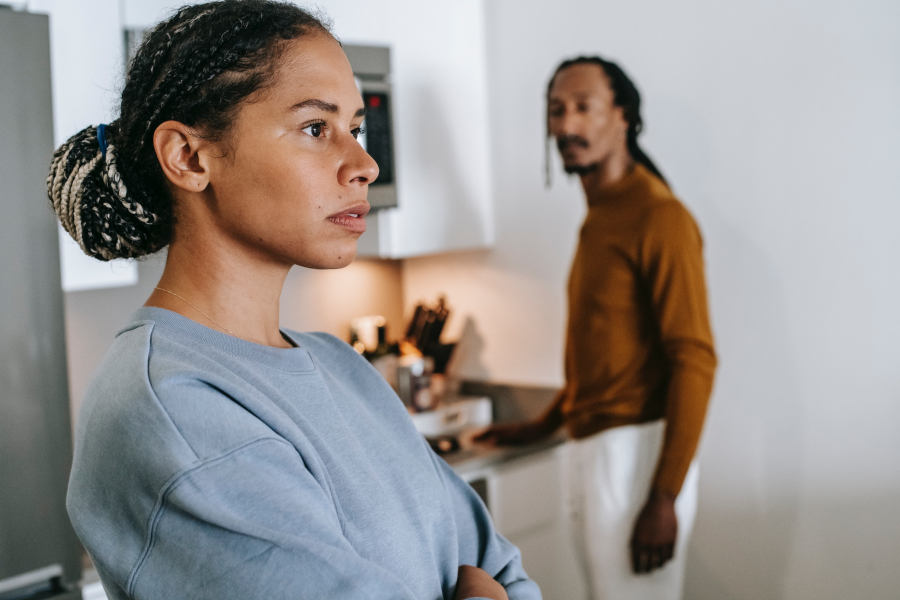Saying no to someone with borderline personality disorder can be a delicate process. If said in the wrong way, it can make them feel rejected and trigger an emotional episode. Navigating these situations without feeling guilty or causing harm can be challenging.
At the same time, setting and maintaining boundaries is paramount for the well-being of those with borderline personality disorder and those around them.
If you have a loved one or family member with borderline personality disorder, it’s crucial to learn how to say no in a kind and loving way. By prioritizing your own mental health, you will not only be better equipped to love and empathize, but you will also promote a healthy relationship.
This article will explore practical tips for setting boundaries with someone with borderline personality disorder. We will explore the importance of boundaries, and the challenges that those with borderline personality disorder face, and provide tips on how to say no with empathy and love.
By understanding borderline personality disorder and the importance of boundaries, you can learn how to set healthy boundaries that are beneficial for both parties involved.
Understanding Borderline Personality Disorder
You need to understand the nature of borderline personality disorder (BPD) in order to communicate effectively with someone with this disorder. BPD is a mental health disorder characterized by unstable and intense emotions, impulsive behaviours, and a distorted sense of self.
People with BPD long for connection, but are terrified of abandonment. Thus, they may find it challenging to maintain stable relationships because they feel extremely sensitive to any sign of rejection. They experience acute pain whenever they perceive someone may be abandoning them, which in turn can cause them to overreact or push people away out of fear and hurt.
BPD is commonly confused with bipolar disorder, but it is important to note that they are completely different. While both conditions can involve intense mood swings, they are very different conditions that require different approaches to treatment.
Recognizing the signs and symptoms of BPD
The Diagnostic and Statistical Manual of Mental Disorders, Fifth Edition (DSM-V), outlines the following common symptoms of BPD:
- Frantic efforts to avoid real or imagined abandonment.
- A pattern of intense and unstable relationships, characterized by alternating between idealization and devaluation.
- Identity disturbance: Markedly and persistently unstable self-image or sense of self.
- Impulsivity in at least two areas that are potentially self-damaging (e.g., spending, sex, substance abuse, reckless driving, binge eating).
- Recurrent suicidal threats, gestures, behaviour, or self-mutilating behaviour.
- Affective instability due to a marked reactivity of mood (e.g., intense episodic dysphoria, irritability, or anxiety usually lasting a few hours and only rarely more than a few days).
- Chronic feelings of emptiness.
- Inappropriate, intense anger or difficulty controlling anger (e.g., frequent displays of temper, constant anger, recurrent physical fights).
- Transient, stress-related paranoid ideation or severe dissociative symptoms.
BPD Episodes
A person with BPD may experience dramatic mood swings and they may struggle with emotional instability. When someone with BPD is triggered, they tend to experience intense and overwhelming emotions that are difficult to regulate or control. They may experience feelings of anger, anxiety, and depression, which can lead to impulsive behaviour and conflict within their relationships.
Their reactions may also include strong emotions, including rage, anxiety, and depression.
When someone with BPD is told “no,” they may perceive it as a sign of abandonment or rejection, and their reaction may seem extreme.
Effects on Others
Simultaneously, the person they are interacting with will often feel pressured to give in to the reaction to avoid escalation. The person may also feel like they are “walking on eggshells” and modify their future behaviour to avoid potential blow-ups.
Although this may seem like a good idea as the path of least resistance, relationships cannot thrive without healthy boundary setting. Learning to set boundaries in a healthy, empathetic, and kind manner is crucial to maintaining any long-term relationship.
List of Potential BPD Triggers
Before discussing how to say no and healthy ways to set boundaries, it is important to be aware of potential triggers. Common triggers for someone with BPD include anything that may result in perceived rejection, criticism, or abandonment.
Rejection or abandonment
People with BPD tend to be triggered by anything they might interpret as a sign of rejection or abandonment. For instance, unexpected delays in text message responses, not being invited to an event, or cancelled plans. Impulsive behaviours are a way for the person with BPD to cope with their fear. Such behaviour might include repeatedly calling or texting someone or engaging in self-destructive behaviours.
Criticism or perceived slight
Criticism, even if well-intentioned, has the ability to trigger a person with BPD emotionally. If they perceive criticism, such as feeling like someone is judging them, disapproving of them, or rejecting their ideas, it can feel like a personal attack on their character and lead to feelings of shame, guilt, anger, or sadness.
Feeling invalidated
Feeling like their emotions or experiences are being dismissed or invalidated can be triggering for individuals with BPD, especially if they feel misunderstood.

The Importance of Setting Boundaries
What is there for a loved one to do? Do you give in to the demands of the person with BPD in hopes of never triggering them? No. Walking on eggshells will breed resentment and likely come out in arguments or result in a disingenuous and broken relationship.
The truth is that healthy boundaries are essential for the well-being of both individuals with BPD and those around them.
Boundaries refer to the limits individuals set for themselves and their relationships. They come in many forms such as physical, emotional, sexual or psychological. They help individuals define their needs, wants, and expectations in relationships.
Individuals with BPD may find it challenging when the other person in the relationship sets a boundary. This is because of the profound way they sense emotions and their overwhelming fears of potential abandonment. However, boundaries can help those with BPD feel more secure in relationships, provide structure and consistency, and reduce their anxiety and impulsivity.
When a person with BPD has clear boundaries, they can better regulate their emotions and behaviour, potentially producing more stable relationships. Boundaries can also prevent the person with BPD from becoming overly dependent on others. Overdependence may lead to unhealthy dynamics in the BPD relationship.
It is important to note that setting boundaries does not mean cutting off individuals with BPD. Instead, boundaries should be set with empathy and understanding of the individual’s struggles. Clear communication, consistency, and understanding are essential for maintaining a healthy relationship with a person with BPD.
In the next section, we will explore how to say no to someone with BPD with empathy and care.

How to Say “No” and Set Boundaries With Love and Empathy
The key to saying “no” and setting boundaries is remembering that people with BPD fear abandonment and rejection. Therefore, you should strive to speak in a loving and empathetic way while respecting your own emotions and firmly maintaining your boundaries. Here are some guidelines that can help you:
Use “I” statements rather than “you” statements
Using “I” statements to express your feelings and needs instead of “you” statements communicates your feelings in a way that is less likely to be perceived as blaming or critical. “You” statements can come across as accusatory, which may trigger a person with BPD’s fear of rejection or abandonment.
For example, “I feel overwhelmed and need some time alone” is more effective than “You are smothering me and need to back off.”
Empathize with their experience

When saying no, approach the conversation with empathy and understanding of the individual’s struggles. One way to do this is to acknowledge and validate the person with BPD’s feelings.
Practice active listening and try using “I” statements that reflect your understanding of their feelings. For example, “I understand that you are feeling hurt by my decision” or “I can see that this situation is causing you a lot of anxiety.” This demonstrates that you recognize the intensity of their emotions and are not dismissing them.
Communicate that you want to understand their experience.
It is essential to communicate gently and compassionately, conveying your empathy while also being clear and direct. Remember, saying no is not about rejecting or invalidating the individual with borderline personality disorder. Instead, it is about setting and maintaining healthy boundaries that benefit both parties.
Do not validate inappropriate behaviour
A person with BPD may engage in impulsive and self-destructive behaviour to cope with their overwhelming feelings. Although it is important to empathize with their emotional experience, it is not advisable to validate inappropriate reactions or behaviours.
This reinforces unhealthy coping mechanisms and makes it more challenging to set healthy boundaries in the future. For example, giving in to their demands or requests when they are threatening self-harm or suicide is not a healthy way to manage their emotional distress.
Avoid apologizing for or justifying your boundaries
It’s okay to say no without offering an apology or justification. You don’t owe anyone an explanation for your boundaries and limitations. If you feel uncomfortable or guilty, take a moment to reflect on why you are feeling that way. It’s natural to want to help others, but it’s important to remember that your needs and limitations are just as valid as anyone else’s.
If you believe you’ve done something wrong, then by all means, you should apologize. But if you feel guilty because of the reaction, it is better to validate the individual with BPD’s emotions while standing firm.
Do not take responsibility for their emotions or try to “save” them
Loved ones of those with BPD may tend to feel responsible for the feelings of the person they care about. This is normal.
However, we are each responsible for our own emotions and cannot take another person’s feelings on ourselves. Although you should certainly try to help someone with BPD, it is ultimately up to them to change themselves.
When a loved one is struggling, it is natural to want to solve their problems. Thinking we can control or fix someone else’s emotional state and make them feel whole again is an alluring trap. However, the complex and multifaceted nature of emotions makes it impossible to regulate how someone else feels. There are too many influencing factors, both within and outside of a person’s control, to make it possible to fix another person’s situation. Therefore, holding yourself responsible for someone else’s emotional well-being is unfair and unrealistic.

Set clear boundaries and do not change your mind
If you need to tell someone with BPD something that you believe might be triggering, it is helpful to be certain about your decision. You may possibly feel pressure to change your mind once you enforce your boundary. However, it’s important that you treat your personal boundaries as non-negotiable.
If you set a boundary and do not stick by it, it reinforces inappropriate behaviour and promotes the idea that boundaries are negotiable.
Provide valid and unambiguous reasons
When saying no, be sure to provide a clear explanation of your decision. This explanation should be respectful, empathetic, and based on specific reasons.
For example, instead of simply saying “I can’t do that,” try saying something like “I’m sorry, I can’t do that because I have a meeting at work that I need to attend.”
This shows that you are being considerate of their request, while also being honest about your limitations.

Reassure them that you are not rejecting them
By reassuring a person with BPD that you are not rejecting them, you can help to ease their fears and reduce the likelihood of an emotional outburst. Use these tips:
- Provide alternatives or compromises: If they are upset about a decision you have made, you might offer an alternative solution that meets both of your needs. This can help to show that you are willing to work with them and that their needs matter to you.
- Remind them how much you love them: Express gratitude for their positive traits and the positive things they bring to your life. For example, you might say, “I really appreciate how much you care about me,” or “I love spending time with you because you make me laugh.”
Don’t take their reactions personally
People with BPD can have extreme reactions to situations that may seem minor or insignificant to others. A natural response is for the other person in the relationship to become defensive or upset. However, taking their reactions personally can exacerbate the situation and lead to further conflict.
When someone with BPD is triggered, it can feel as if their very survival is at risk. They may react in ways that seem extreme or out of proportion. The intense emotions and reactions experienced by someone with BPD are often not about the situation at hand, but rather a result of their perceptions and underlying condition.
Stay calm and find ways to decrease your own reactivity
By not taking their reactions personally, you can help to de-escalate the situation and prevent it from becoming more intense. Try to remain calm and non-judgmental, and acknowledge their feelings without necessarily agreeing with their behaviour.
You can help to provide a safe and supportive environment for the person with BPD by staying focused on the issue at hand and not taking their reactions personally

To help someone with BPD, first take care of yourself
BPD can be a challenging and emotionally exhausting condition to deal with, and it is easy to become overwhelmed and burnt out. You need to prioritize your self-care to provide the best support possible for someone with BPD.
By taking care of yourself, you will be in a better place to help the person with BPD feel understood and validated. This can also aid in de-escalating situations and preventing further damage.
Seek help from a mental health professional
If you are struggling with setting boundaries or finding it difficult to support a person with BPD, it can be helpful to seek professional help. A psychotherapist or psychologist can provide valuable insights, strategies, and support to help you manage difficult situations. Professional mental health services can make a significant difference in BPD relationships.
Couples therapy can also be a valuable resource. Couples therapy is a type of therapy that is designed to help couples improve their communication, reduce conflict, and strengthen their relationship. For couples in which one partner has BPD, therapy can help to reduce the intensity of emotional outbursts, and help both partners to better understand each other’s perspectives.
Conclusion
Saying no to your loved one with borderline personality disorder can be challenging, but it’s essential for maintaining a healthy relationship. By setting healthy boundaries, you can prioritize your own mental health, needs, and limitations while still being supportive and compassionate toward your loved one. Remember to be clear and specific when communicating your boundaries, avoid taking responsibility for someone else’s feelings, and prioritize self-care as an act of kindness towards yourself and your relationship.
It’s natural to want to help and support someone you care about, but it’s crucial to set healthy boundaries that respect your own needs and limitations. With patience, understanding, and a commitment to self-care, you can build stronger and more fulfilling relationships with those who struggle with BPD.
Frequently Asked Questions
How do you disagree with someone with BPD?
It’s essential to approach the conversation with empathy and respect. Use “I” statements to express your perspective without attacking or blaming the person. Active listening and validating their feelings can also help de-escalate the situation.
What not to do to a person with Borderline Personality Disorder?
Avoid invalidating their emotions, using labels or stereotypes, engaging in power struggles, or becoming emotionally reactive. Focus on empathetic communication, active listening, and setting clear boundaries to promote healthy relationships.
Is it okay to say no to someone with BPD?
Yes, it is essential to set and communicate boundaries to maintain healthy relationships, even with someone with BPD. However, it is crucial to do so with empathy and compassion.
Should I feel guilty for saying no to someone with BPD?
It’s common to feel guilty or responsible for other people’s emotions, especially when they have BPD. However, it’s important to remember that you have the right to set your own boundaries and prioritize your own needs. You are not responsible for someone else’s emotional reactions or behavior.
What if the person with BPD becomes angry or upset when I say no to them?
If the person with BPD becomes angry or upset when you say no, it’s important to remain calm and empathetic. Validate their feelings, but also communicate your perspective and set clear boundaries. If the situation becomes too intense, it may be necessary to disengage and revisit the conversation at a later time.
How can I support someone with BPD without sacrificing my own needs?
Prioritize your own needs and boundaries, communicate clearly, and seek support from a mental health professional or support group. Practice self-care and establish healthy coping strategies to manage stress and emotional dysregulation. Provide support without sacrificing your own well-being.








